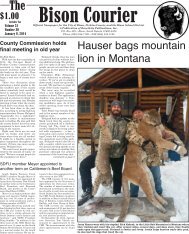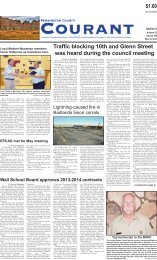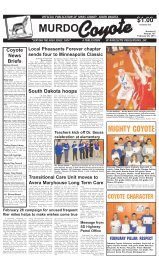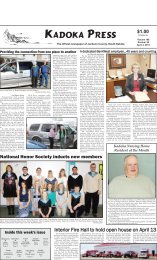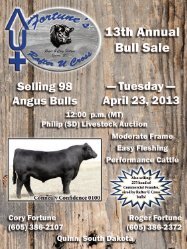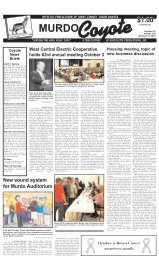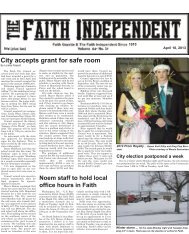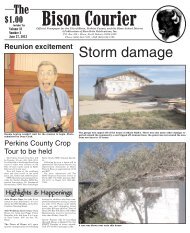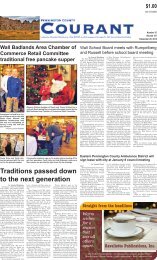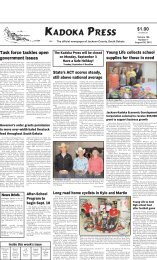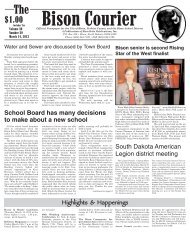Create successful ePaper yourself
Turn your PDF publications into a flip-book with our unique Google optimized e-Paper software.
News …<br />
Boating safety emphasized<br />
by Game, Fish and Parks Agriculture Secretary Tom Vil-<br />
Water temperatures are warming<br />
in South Dakota, and boaters<br />
typically begin to take to the water<br />
in greater numbers as the July<br />
Fourth holiday approaches.<br />
In an effort to help keep those<br />
boaters safe on South Dakota’s<br />
public waters, the Department of<br />
Game, Fish and Parks (GFP) will<br />
step up its efforts over the next few<br />
weekends to conduct boating safety<br />
checks across the state.<br />
“While GFP conservation officers<br />
routinely conduct boating<br />
safety checks during much of the<br />
year, these stepped up efforts are<br />
being made as part of a nationwide<br />
boating safety campaign in conjunction<br />
with the National Association<br />
of Boating Law<br />
Adminstrators (NASBLA),” said<br />
Brandon Gust, GFP boating safety<br />
coordinator.<br />
Before heading onto the water<br />
this summer, Gust encourages<br />
boaters to take a close look at their<br />
fire extinguishers, life jackets,<br />
throwable seat cushions and other<br />
equipment to be sure they’re in<br />
good working condition. “The best<br />
way to prevent an unwanted<br />
tragedy on the water is to be prepared.”<br />
If boaters are uncertain what<br />
safety equipment they are required<br />
to have onboard, Gust suggests<br />
that they pick up a copy of the<br />
South Dakota Boating Handbook<br />
at the nearest GFP Office, state<br />
park, GFP-license outlet or by<br />
going online at<br />
h t t p : / / g f p . s d . g o v / f i s h i n g -<br />
boating/boating/<br />
The following list of required<br />
safety equipment serves as a quick<br />
reference, but Gust suggests that<br />
boaters take a few minutes to review<br />
other safety regulations in the<br />
South Dakota Boating Handbook.<br />
The majority of boats in South<br />
Join us for an Open House<br />
Stop down to visit!<br />
Friday and Saturday<br />
from 2 to 5 p.m.<br />
14 miles south of Kadoka on Hwy 73,<br />
3 miles east on Swift Horse Road<br />
Be sure<br />
to stop in<br />
& sign up<br />
for our<br />
DRAWING!<br />
We’re so glad to have you drop in!<br />
Enjoy the 2012<br />
Alumni Celebration!<br />
Your area full-service<br />
grocery store.<br />
We can fill all your<br />
grocery needs<br />
during alumni<br />
weekend!<br />
Open Monday thru Saturday • 8 a.m. - 6 p.m.<br />
837-2232 • Main Street • Kadoka, SD<br />
Dakota are required to carry:<br />
•One U.S. Coast Guard-approved<br />
wearable, properly sized<br />
personable flotation device for each<br />
person aboard<br />
•One U.S. Coast Guard-approved<br />
throwable type flotation device<br />
(seat cushion or ring buoy) for<br />
vessels 16 feet or longer<br />
•One U.S. Coast Guard-approved<br />
fire extinguisher of B-1 type<br />
or larger for vessels with enclosed<br />
gas compartments<br />
While state regulations require<br />
that children under the age of<br />
seven must wear their life jackets<br />
anytime a boat is moving on the<br />
water at ‘greater than no-wake<br />
speed,’ Gust encourages parents to<br />
have all children wear life jackets.<br />
Gust also emphasizes that parents<br />
should check to be sure each child<br />
has a properly sized lifejacket to<br />
ensure it doesn’t come off when<br />
they jump into the water.<br />
“Of course, it goes without saying<br />
that life jackets will not keep<br />
anyone afloat, young or old, if<br />
they’re not wearing them,” said<br />
Gust.<br />
Boating accidents present a special<br />
safety concern, and Gust asks<br />
that boaters be especially mindful<br />
when other boats are present.<br />
“Many times we see boat accidents<br />
that involve inexperienced<br />
operators, but careless or reckless<br />
operators present a problem for<br />
everyone,” he said.<br />
Finally, Gust asks that boat operators<br />
do their part to make for a<br />
safe outing and limit alcohol consumption.<br />
“The safety of everyone aboard a<br />
boat depends on having a sober and<br />
competent boat operator,” he said.<br />
“While open containers of alcohol<br />
are allowed in boats, we want to<br />
ensure that each boat has a designated<br />
sober operator at all times.”<br />
USDA seeks applications for grants<br />
to help rural businesses create jobs The days of cutting hay on an In-<br />
sack has announced that USDA is<br />
accepting applications for grants to<br />
help promote sustainable economic<br />
development and job creation in<br />
rural communities.<br />
"Cooperative enterprises often<br />
lead economic growth and job creation<br />
in rural areas," Vilsack said.<br />
"USDA is offering grants to help organizations<br />
start cooperatives, expand<br />
existing ones or help develop<br />
business opportunities in rural<br />
areas."<br />
USDA is offering Rural Cooperative<br />
Development Grants (RCDG)<br />
to non-profit corporations and institutions<br />
of higher education. The<br />
grants also may be used to conduct<br />
feasibility studies, create and implement<br />
business plans, and help<br />
businesses develop new markets<br />
for their products and services.<br />
One-year grants up to $175,000<br />
are available. In most cases, grants<br />
may be used to pay for up to 75 percent<br />
of the cost of establishing and<br />
operating rural cooperative development<br />
centers. Recipients are required<br />
to match 25 percent of the<br />
award amount. The grant period<br />
should begin no earlier than October<br />
1, 2012, and no later than January<br />
1, 2013.<br />
Many RCDG recipients have a<br />
long history of job creation and economic<br />
development. In Great Falls,<br />
MT, the Montana Cooperative Development<br />
Center has helped 123<br />
entities and guided the formation<br />
of 37 cooperatives since its inception<br />
in 1999. One of these cooperatives,<br />
the Last Chance Café, in<br />
Sunburst, MT, near the Canadian<br />
border, would have closed without<br />
help from the development center<br />
and its USDA Rural Cooperative<br />
Development Grant. This iconic<br />
café is once again a successful local<br />
diner and a gathering spot for the<br />
local community.<br />
Through this notice, USDA may<br />
award up to $5.8 million in grants.<br />
The deadline for RCDG applications<br />
is August 6, 2012. For additional<br />
information, see the June 7,<br />
2012 Federal Register or contact<br />
the USDA Rural Development<br />
state office.<br />
In addition, USDA is offering almost<br />
$2.37 million in grants<br />
through USDA Rural Development's<br />
Rural Business Opportunity<br />
Grant (RBOG. The program promotes<br />
sustainable economic development<br />
in rural communities and<br />
regions with exceptional needs.<br />
For example, in 2011, USDA<br />
Rural Development awarded<br />
Kadoka, SD • 837-2350<br />
Welcomes Everyone<br />
to the 2011 KHS<br />
Alumni Celebration!<br />
TRY OUR FRESH, HOT<br />
PICCADILLY PIzzA!<br />
Plus many other<br />
DeliCiOuS hot food items!<br />
Y Breakfast Burritos<br />
Y Iced Coffee<br />
Y Pizza<br />
Y Chicken Tenders<br />
Y BBQ Bites<br />
Y Bread Sticks<br />
Y Burgers<br />
Y Gift Cards<br />
Southwestern Wisconsin Regional<br />
Planning Commission a $90,000<br />
grant to assist with the development<br />
of a local food prospectus for<br />
rural areas in the tri-state region of<br />
Wisconsin, Iowa and Illinois. The<br />
Commission will use the grant<br />
award with partner agencies in<br />
Wisconsin, Illinois and Iowa to improve<br />
the local food opportunities<br />
in the tri-state region. The twoyear<br />
effort will identify agricultural<br />
strengths, regional opportunities,<br />
and recommend a unified network<br />
of processing, storage, and distribution<br />
facilities throughout the region.<br />
The RBOG program provides<br />
training and technical assistance<br />
grants for business development,<br />
entrepreneurs, and economic development<br />
officials and assists with<br />
economic development planning.<br />
Funding is available to rural public<br />
bodies, nonprofit corporations, Native<br />
American tribes and cooperatives<br />
with primarily rural members<br />
that conduct activities for the mutual<br />
benefit of the membership.<br />
Applications for Rural Business<br />
Opportunity Grants are due August<br />
6, 2012. Application instructions<br />
may be obtained from the<br />
June 7, 2012 Federal Register, or<br />
by contacting a USDA Rural Development<br />
State Office.<br />
Since taking office, President<br />
Obama's Administration has taken<br />
historic steps to improve the lives<br />
of rural Americans, put people back<br />
to work and build thriving<br />
economies in rural communities.<br />
From proposing the American Jobs<br />
Act to establishing the first-ever<br />
White House Rural Council –<br />
chaired by Agriculture Secretary<br />
Tom Vilsack – the President is committed<br />
to using Federal resources<br />
more efficiently to foster sustainable<br />
economic prosperity and ensure<br />
the government is a strong<br />
partner for businesses, entrepreneurs<br />
and working families in<br />
rural communities.<br />
USDA, through its Rural Development<br />
mission area, administers<br />
and manages housing, business<br />
and community infrastructure and<br />
facility programs through a national<br />
network of state and local offices.<br />
Rural Development has an<br />
active portfolio of more than $165<br />
billion in loans and loan guarantees.<br />
These programs are designed<br />
to improve the economic stability of<br />
rural communities, businesses, residents,<br />
farmers and ranchers and<br />
improve the quality of life in rural<br />
areas.<br />
Kadoka Gas & Go<br />
Now Renting<br />
DVD Movies!<br />
We also offer<br />
propane<br />
exchange!<br />
June 21, 2012 • Kadoka Press • Page 6<br />
Putting up high quality hay<br />
ternational H or M tractor with a<br />
sickle mower are long gone for<br />
most, says Julie Walker, SDSU Extension<br />
Beef Specialist.<br />
"It seemed like a field took forever<br />
to finish cutting. I clearly remember<br />
the day that Dad<br />
purchased a 12-foot mower with<br />
conditioner. Boy could you lay<br />
down the hay with that piece of<br />
equipment," Walker said, of her<br />
childhood growing up on a farm in<br />
Minnesota. "Needless to say, hay<br />
equipment has improved over the<br />
last few decades."<br />
Although equipment has improved,<br />
there are still many decisions<br />
Walker says producers still<br />
need to make to ensure hay quality<br />
is adequate. The decisions producers<br />
make as managers of forage resources<br />
will hopefully reduce the<br />
amount of supplementation that<br />
will be required to meet the animal<br />
nutrient requirements.<br />
What is high quality hay?<br />
"Many producers would say<br />
quality hay is green in color, free of<br />
mold and weeds, has a high portion<br />
of leaves and it was put up without<br />
rain on it," said Walker, adding<br />
that although these are good indicators<br />
of high quality hay, they<br />
don't tell producers anything about<br />
the nutritional content of the forage.<br />
Sampling is the best way to understand<br />
the nutritional content of<br />
forage, Walker says.<br />
"Producers need to sample the<br />
hay once it is in the stack and send<br />
the sample to a lab for nutritional<br />
analysis. This is essential to understanding<br />
its true quality," she said.<br />
What are the best management<br />
practices that should be considered<br />
to improve the odds of getting a<br />
stack of high quality hay?<br />
To answer this question, Walker<br />
first asks producers if they go for<br />
quantity, or quality?<br />
"Forage has the highest digestibility<br />
in the vegetative stage,<br />
and is less digestible at seed stage.<br />
As the plant matures from vegetative<br />
to seed stage, the digestibility<br />
decreases and the amount of biomass<br />
available for harvest increases,"<br />
she says.<br />
Figure 1 shows that maximum<br />
yield of digestive dry matter. For<br />
grasses, the maximum yield of digestive<br />
dry matter would be obtained<br />
at the late boot to early head<br />
stage of maturity and for legumes,<br />
the mid-to late-bud stage of maturity<br />
is best.<br />
Taken from Schroeder, 1996,<br />
NDSU<br />
Research has shown that forage<br />
cut at or near sundown has higher<br />
energy compared to morning.<br />
"This is a natural physiological<br />
process in plants wherein concentrations<br />
of soluble carbohydrates<br />
and other highly digestible nutrients<br />
are highest after a full day of<br />
sunshine and photosynthesis,"<br />
Walker said.<br />
She adds that tall enough stubble<br />
height should be left to aid in<br />
drying as well as improves pickup<br />
performance.<br />
"However, too high of stubble<br />
height will reduce yields," she says.<br />
Correct hay curing (drying) is<br />
the next step. Walker says various<br />
factors can reduce hay quality during<br />
the drying phase, these include;<br />
respiration, weather and loss of<br />
leaves. Some tips she shares to<br />
speed up curing include; using a<br />
mower conditioner speeds drying<br />
by opening the waxy layer surrounding<br />
the stems in legumes;<br />
large and/or coarse stemmed forages<br />
have shown faster drying<br />
when conditioned. Wider swaths<br />
also allow for faster drying. Raking<br />
should be avoided if possible when<br />
the forage moisture is less than 40<br />
percent.<br />
Hay desiccants are used to reduce<br />
the amount of time required<br />
for hay drying. The commonly used<br />
hay desiccants are potassium carbonate<br />
or sodium carbonate, which<br />
are sprayed onto the hay during<br />
the cutting phase.<br />
Walker says hay desiccants are<br />
effective on alfalfa, clover and<br />
birdsfoot trefoil to remove the<br />
moisture-conserving waxy cutin<br />
layer of the plant, however, they<br />
are ineffective on grasses such as<br />
orchardgrass, timothy and<br />
bromegrass.<br />
"When considering using hay<br />
desiccants remember to include the<br />
cost of the chemical as well as the<br />
sprayer for application," she said.<br />
Walker adds that reducing leaf<br />
loss during the baling phase is key<br />
to maintaining quality.<br />
"Baling at moisture content<br />
above 15 percent, has less leaf loss<br />
than below 15 percent. Typical<br />
moisture content of the bales needs<br />
to be below 18 to 20 percent to prevent<br />
mold growth," she said. "When<br />
putting up hay with higher moisture<br />
content other management<br />
steps need to be implemented to<br />
ensure maintaining hay quality as<br />
well as reducing the risk of fire."<br />
Feed costs are a large portion of<br />
your annual cow cost, so managing<br />
the forage resource to get a quality<br />
hay product, which will reduce the<br />
need for additional supplementation,<br />
can ultimately reduce the feed<br />
bill. For more information visit,<br />
www.igrow.org.<br />
Dream Big - READ!<br />
Summer Reading Program<br />
at the Jackson County Library<br />
Notice to our Subscribers:<br />
When sending subscription payments<br />
PLEASE return the<br />
entire pink postcard<br />
The Kadoka Press welcomes<br />
everyone to the<br />
Kadoka alumni days<br />
Celebration!<br />
Following the Alumni Days weekend celebration,<br />
if you have a group photo of your class, we would be<br />
most happy to publish them in the paper!<br />
Please email photos to: press@kadokatelco.com<br />
or editor@kadokatelco.com<br />
On Wednesday Afternoons<br />
3 p.m. • Ages 3-6<br />
Come Join the FUN!<br />
If you would like a copy of the June 28th issue, which will have coverage of celebration,<br />
please send $3.00 to cover the cost of the paper, postage and handling<br />
and we will mail an issue to you. Make sure you include your full address.<br />
Kadoka Press -- Ronda & Robyn



